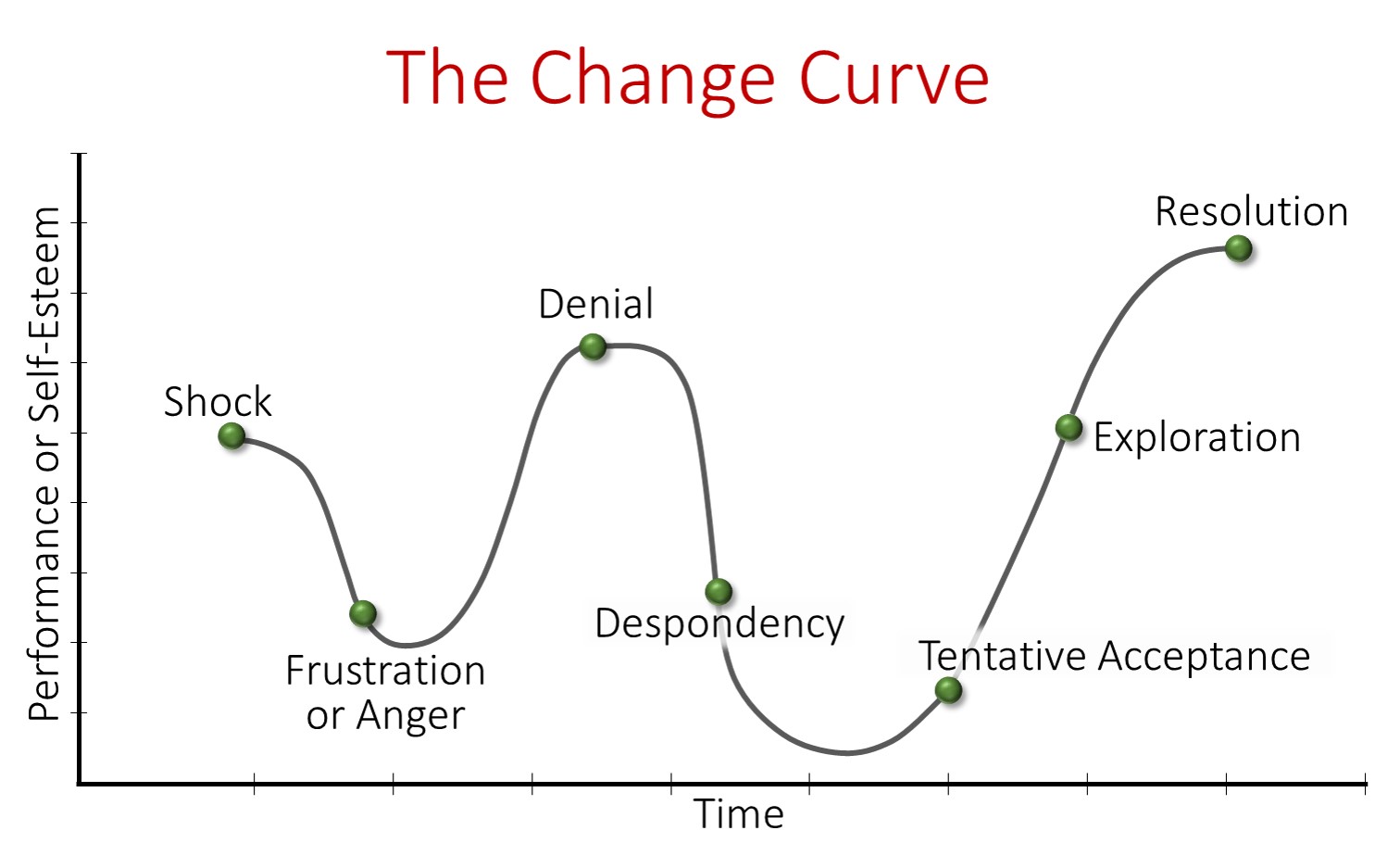The challenges of creating sustained change.
Like most people, you have probably made New Year’s Resolutions or other decisions to change something in your life, your diet, career or habits maybe, but found yourself failing to implement or sustain the changes. You are not alone; research by the University of Scranton indicates that just 8% of people achieve and maintain their New Year’s goals and this is when people actually want to change!
In an organisational context where the pressure to change is imposed by senior managers or external forces, the challenge takes on yet another dimension.
The failure rate for strategic change programmes is consistently reported by researchers at 80% or higher! The costs of getting these wrong are high – indeed, it can mean losing competitiveness, corporate failure and the ousting of senior executives. And the main culprit: people didn’t change.
So, how do you best help people change and adapt to change?

The Change Curve
When we train mangers in change leadership we often refer to a well-recognised change curve model, developed by Kübler-Ross.
The Change Curve was first used in bereavement counselling, but it was soon recognised as having a clear application in change leadership. This is because change involves the loss of the familiar, which is never easy. Changes at work often generate similar patterns of feelings as people experience in bereavement.
People will differ in how long and at what magnitude they experience these emotions. Those who are more accustomed and comfortable with change may move more swiftly towards the final stages.
The Change Curve helps to understand the stages of personal transition and organisational change. It helps you predict how people will react and progress through this series of very human emotions so that you can support them through their own personal transitions.
Helping people through the change stages
Shock
At the first stage people can struggle to come to terms with the situation and accept the new reality.
If you know that change is coming, you can reduce the initial shock by preparing those who will be affected by it. Be open and share information about factors influencing the organisation, which may in time lead to some necessary changes.
The worst thing you can do is to pretend that all is OK and that nothing is going to change. In doing so, you risk that the shock and resistance will be worse when change does come, and peoples’ trust in you will likely be damaged.
Give people time to come to terms with the news and move towards the next emotional stage.
Be empathic, listen to people’s concerns and recognise that you as a leader may have had more time to come to terms with the change and have had more influence on the decision, details or process.
Frustration/Anger
Once past the shock, your team will start questioning and challenging the rationale for the changes and the effect it will have now or in the future.
- Acknowledge their concerns.
- Explain the rationale for the change very clearly and find out if they need more information.
- Find out what you can do to deal with their most immediate or significant concerns.
Denial
Here people will start to deny that the change will affect themselves or that it will actually happen. They may try to convince themselves that it only affects others, or that it is temporary.
- Keep repeating the message.
- Be clear, in a supportive way, about what is non-negotiable if anything.
- Provide as much information as you are able on the future and the plan to get there.
Despondency
At this stage, team members will start to realise that the changes are here to stay and what new demands will be placed on them. Morale may well drop.
- Take what actions you can to deal with peoples’ immediate concerns.
- Focus on morale and build in some shorter-term wins and celebrate them.
- Give re-assurance and affirmation.
- Encourage and boost people’s confidence and self-belief.
- Convey an air of positive, calm confidence.
Tentative Acceptance
Here the team members, and you, start to see some green shoots of hope. There is an increase in confidence and acceptance that the change may be successful and have some benefits after all.
- Be thankful that you have reached this stage but remain vigilant in ensuring people adhere to the new ways of working.
- Provide effective coaching to improve the successes gained.
- Stay honest with what is working and what is not.
- Praise the progress made and give positive feedback on individual and team contributions.
Exploration
There is now a widening of acceptance and increase in confidence which produces bursts of fresh energy and endeavour.
- Be aware of those struggling to move into the final stages.
- Review and check understanding of new ways of working.
- Be very clear about the new ways of working and what must not to be done any more. You don’t want people to slip back into old, unwanted behaviours.
Resolution
The desired change(s) have now been embedded. People are comfortable with the new way of working and it has become the new norm.
- Provide greater involvement and responsibility to help ensure ongoing success.
- Celebrate the successes with everyone.
- The change will produce growth in experience and capacity, which may lead to new opportunities.
Conclusion
As a leader needing to make changes within your organisation, the challenge is not only to get the systems, process and structures right, but also to help and support people through these individual transitions, which can sometimes be intensely traumatic, and involve loss of power and prestige. The easier you can make this journey for people, the sooner your organisation will benefit, and the more likely you are to be successful.
If you are going through a period of change right now, a merger or acquisition, or perhaps installing new working practices or adopting new technology, I’d be happy to have a conversation about how we can use coaching to help people come along on the journey.
Back to News & Blogs Overview
